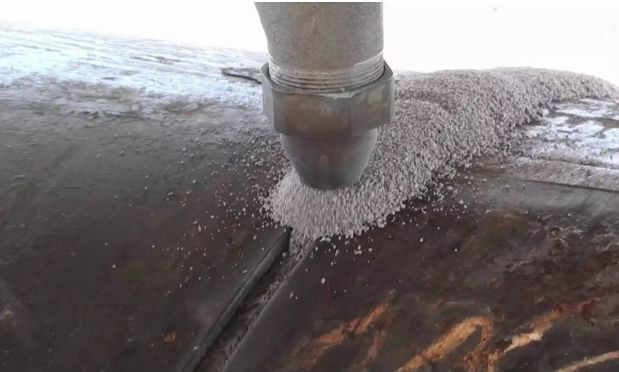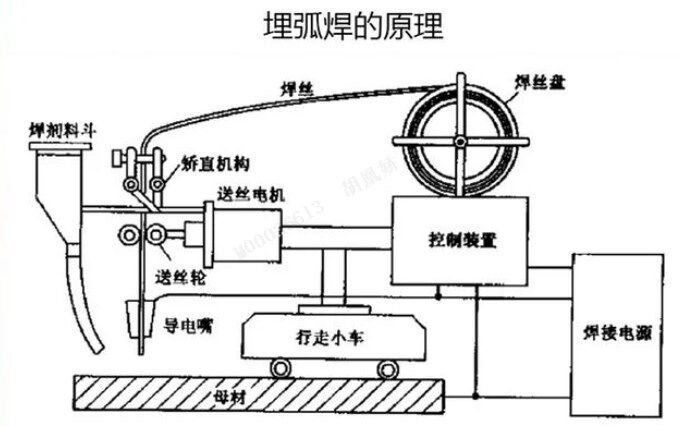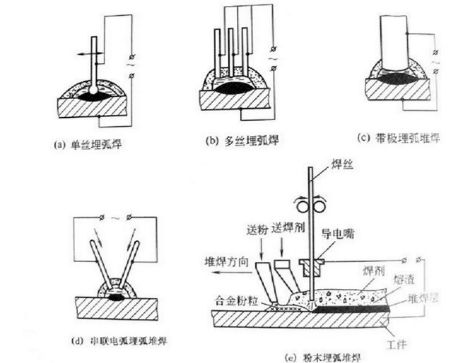In the vast world of industrial welding, some methods stand out for their efficiency, precision, and adaptability. Submerged Arc Welding (SAW) is one such gem, revered for its unparalleled performance in joining thick plates and creating durable structures. Whether you're new to welding or a seasoned professional, this guide will unravel the core concepts and practical applications of SAW Welding, leaving you equipped with insights to elevate your expertise.
I. What Is Submerged Arc Welding?
Submerged Arc Welding (SAW) is an advanced, automated welding process that utilizes an electric arc as its heat source. The arc, hidden beneath a layer of granular, fusible flux, operates in a concealed environment. This unique setup minimizes contamination, ensuring a high-quality weld.

The process involves a continuously fed bare wire electrode that melts under the arc’s heat. The flux, which melts alongside the electrode, forms a protective slag layer over the molten pool. This shields the weld from atmospheric interference, resulting in superior weld integrity. The slag solidifies post-welding, further enhancing mechanical properties and corrosion resistance.
II. The Working Principle of SAW Welding
Arc Formation: The welding power source supplies direct or alternating current to generate an arc between the electrode and the workpiece.
Flux Coverage: Granular flux is automatically deposited over the welding area, melting under the arc to form a protective barrier.
Protection: The melted flux creates a shield that prevents oxygen, nitrogen, and moisture from contaminating the weld pool.
Melting and Solidification: The intense heat melts the electrode and base material, creating a weld pool that solidifies into a robust joint.
SAW is a go-to solution for heavy industries, known for its high-speed operation, minimal heat-affected zones, and superior weld quality.

III. Key Parameters and Techniques in SAW Welding
The key process parameters for submerged arc welding (SAW)include welding current, arc voltage, welding speed, and electrode diameter. The selection of these parameters directly affects welding quality and production efficiency. Common methods for selecting process parameters include lookup tables, experimental methods, empirical approaches, and calculations. The primary goal is to ensure stable arc burning and that the weld shape and dimensions meet design requirements.
1. Electrode Feeding and Melting
In SAW, the electrode is connected to the power source through a contact tip, and the welding current is transmitted to the arc via the electrode. The electrode melts continuously under the heat of the arc, and a motor-driven wire feeding system ensures steady feeding. The feeding speed of the electrode must match its melting rate to maintain a continuous and stable welding process.
2. Single-Wire, Twin-Wire, and Multi-Wire Submerged Arc Welding
SAW can be performed using single-wire, twin-wire, or multi-wire setups, depending on application requirements. Single-wire welding is suitable for thinner workpieces, while twin-wire and multi-wire welding enhance production efficiency and are ideal for thicker plates. Additionally, flux-cored wires or steel strips can be used as substitutes for solid wires in specific welding scenarios, further improving flexibility and weld quality.

IV. Advantages and Disadvantages of SAW Welding
1. Advantages
High Efficiency and Deep Penetration: SAW achieves high thermal efficiency due to the use of large welding currents and the insulation effect of flux and slag. This allows for deep penetration. Single-wire SAW can weld steel plates up to 20mm thick without the need for beveling.
Fast Welding Speeds: The welding speed of SAW is significantly higher than traditional manual welding methods. For instance, single-wire SAW can weld 8-10mm thick steel plates at speeds of 50-80 cm/min, compared to 10-13 cm/min for manual arc welding.
Excellent Weld Quality: During SAW, the flux effectively isolates the molten pool from the air, slowing the solidification of the molten metal. This reduces the likelihood of defects such as porosity and cracks. The flux can also add alloying elements to the molten metal, improving the mechanical properties of the weld.
Stable Automated Welding:SAW supports automated adjustments of welding parameters during the process, ensuring stability and reducing reliance on the operator’s skill level. This significantly enhances production efficiency.
2. Disadvantages
Limited Applicability: Due to the use of granular flux, SAW is generally suitable only for flat welding positions. Special measures are required to ensure the flux covers the weld area in other positions.
Inability to Observe the Arc Directly: The arc is covered by flux during welding, making it impossible to observe the welding process directly. Without an automatic tracking system, misalignment may occur.
Unsuitability for Thin Sheets: When the welding current is below 100A, arc stability is poor, making SAW unsuitable for welding sheets thinner than 1mm.
V. Applications of SAW Welding
Thanks to its high welding efficiency and mechanized operation, SAW is widely used for welding long seams on medium-to-thick plates. Here are some typical application areas:
Shipbuilding: The assembly of steel plates for ship hulls often requires long weld seams. SAW enhances welding speed while ensuring quality.
Pressure Vessels: The deep penetration and high efficiency of SAW make it indispensable in the manufacturing of boilers and pressure vessels.
Bridges and Lifting Machinery: These large structural components demand high weld strength and fatigue resistance. SAW improves weld quality by adding alloying elements through the flux.
Nuclear Power Plant Structures: SAW excels in applications requiring high precision and safety, particularly in welding pressure equipment and structural components for nuclear power plants.
Additionally, SAW can be used not only for joining components but also for surfacing wear-resistant or corrosion-resistant alloy layers on base metals, further broadening its application scope. With advancements in welding metallurgy and materials, SAW can now be applied to a wider range of materials, including traditional carbon structural steel, low-alloy structural steel, stainless steel, heat-resistant steel, and some non-ferrous metals such as nickel-based alloys, titanium alloys, and copper alloys.
VI. Why Are the Megmeet SA1000/SA1250 Submerged Arc Welding Machines Popular in the Market?
In industrial welding, particularly in sectors such as boilers, pressure vessels, shipbuilding, steel structures, and wind power, the performance of welding equipment directly impacts production efficiency and weld quality. The Megmeet SA1000/SA1250 submerged arc welding machines stand out in these fields due to their multifunctional design and advanced technical features, offering significant competitive advantages.

Versatile Functionality: The SA1000/SA1250 machines support submerged arc welding (SAW), carbon arc gouging, and manual metal arc welding (MMA), greatly expanding their applicability and flexibility. Whether it’s large-scale welding or specific welding requirements, these machines handle tasks with ease. Their dual-mode operation—constant current (CC) and constant voltage (CV)—ensures stable welding quality across diverse scenarios, meeting stringent industrial standards.
Adaptability and Durability: Designed for diverse and complex production environments, the machines feature a wide input voltage range, allowing them to operate reliably under fluctuating power conditions. With an IP23 protection rating, they are suitable for harsh environments, ensuring durability and long-term stability. Additionally, the machines boast a high duty cycle (100%), enabling continuous welding at high currents, significantly boosting production efficiency.
Safety and Smart Features: The SA1000/SA1250 are equipped with intelligent safety features such as overheat protection to safeguard the equipment during extreme working conditions. They also support USB firmware upgrades, RFID card management, and cluster control, making daily maintenance and management more efficient and straightforward, simplifying operation processes.
Long-Distance Capability: For remote operations, the machines maintain excellent welding performance even when the cable extends up to 100 meters. These combined features make the SA1000/SA1250 ideal for medium-to-thick plate welding applications, improving weld quality and efficiency while standing out in an increasingly competitive market.
VII. Safe Operating Techniques for Submerged Arc Welding
While submerged arc welding offers numerous advantages, safety during operation is paramount. Key safety measures include:
Machine Insulation and Grounding: Ensure the welding machine’s wires and control box are properly insulated and grounded to prevent electrical leakage or shock incidents.
Flux Protection: Maintain a sufficient supply of flux during welding to prevent arc exposure, which could cause intense arc light that harms the eyes.
Protective Measures: Although SAW produces minimal smoke, harmful gases may still be released during welding. Effective local exhaust ventilation systems should be installed to ensure operator safety.
Conclusion
As an efficient automated welding method, submerged arc welding has become indispensable in modern industrial manufacturing due to its high productivity, superior weld quality, and broad application range. By selecting appropriate welding parameters and adhering to strict safety protocols, SAW welding enables efficient and stable welding operations in large-scale industrial production, meeting the demands of various structural fabrications.
This welding process has demonstrated immense potential and growth opportunities, particularly in high-demand industries such as heavy machinery, pressure vessels, and nuclear power plants. Among SAW welding equipment, the Megmeet SA1000/SA1250 series saw welding machines stand out for their advanced technological features, significantly enhancing industrial manufacturing efficiency and cementing their place as market favorites.
Related articles:
1. In-Depth Analysis of 8 Common Defects in Submerged Arc Welding
2. Submerged Arc Welding (SAW) Vs. Gas Shielded Welding (GMAW)
3. Blow Holes Defect in Submerged Arc Welding: Causes & Solutions
4. Container Welding Guide: Techniques, Equipment, Quality Control
5. AWS D1.2: Aluminum Structural Welding Standard Guide







